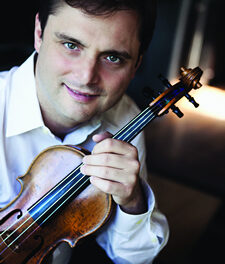The eight-year partnership between the North Carolina Symphony and Peace College has brought us many evenings of enjoyable chamber music by the Symphony musicians and visiting artists. The partnership began somewhat tentatively, but has recently acquired a more permanent basis through a generous gift from Peace College alumna Sara Jo Manning. Held in the College’s Kenan Recital Hall, the concerts are open to the public free of charge.
Monday night’s concert featured seven members of the NCS – Rebekah Binford and Eric McCracken violins, Paul Malcolm viola, Lisa Shaughnessy cello, Michel Schultz oboe and English horn, and Chris Caudill and Rachel Niketopoulos French horn – in a program of Mozart, Schubert and Eric Ewazen.
Mozart composed the Divertimento in D Major, K.251 – a septet for oboe, two horns two violins, viola and cello – for private performance in July 1776, the Name Day and 25th birthday of his beloved sister Nannerl. It is probable that on that occasion it was performed as a septet alone, but a year later Mozart transcribed it for a full orchestra to be performed at the court in Salzburg to celebrate the end-of-term at the University.
The Divertimento has an intrinsic balance problem, which was apparent in this performance. In the upper register, the first violin and oboe hold a constant conversation, but the sound of the oboe dominates – a violin is simply no match for an oboe. It’s an issue that also crops up in the [reconstructed] Concerto for Violin and Oboe by Bach. Otherwise the performance was spirited, cheery and celebratory, as befits the occasion of the work’s composition.
This horn parts for this Divertimento were written for the natural (valveless) horn, called Waldhorn in German, which Caudill and Niketopoulos used for this performance. In a demonstration before the performance, they showed how they have to fudge to get the right notes when there are no handy valves to change the length of the air column. Valved horns came into use only gradually in the nineteenth century. And the melodic and harmonic limitations of the natural horn account for the sameness and harmonic conservatism in horn music – even Mozart’s four concerti – from before the invention of the modern instrument.
A problem we repeatedly encounter at concerts is the sloppiness of printed programs, which are not properly checked and proofread. A case in point, the next piece on the program, listed as Schubert’s “String Quartet No.10 in E-flat, ‘Quartettsatz,’ D.87.” It turned out that what was actually played, however, was the Quartet No.12 in C minor, D.703, the famous “Quartettsatz.” This is the only finished movement for a planned string quartet which Schubert abandoned after a few bars into the second movement. It is a passionate, high-intensity work; a drastic shift in mood from the Mozart and it was good to have the intermission between the two. The performance had intensity and fire, and great precision in the mysterious opening and the two sudden anguished outbursts in the development.
The program ended with a novelty, the Quintet for English horn and String Quartet by Eric Ewazen (b.1954). A prolific composer who has been teaching at Juilliard since 1980, Ewazen’s musical language is partly neo-classical partly Romantic. The Quintet, an 18-minute work composed in 1989, was originally for Heckelphone – a bass oboe, best known for its use in Richard Strauss’ opera Salome. Ewazen has transcribed his Quintet for English horn as well as for tenor sax. In the opening and closing movements, the music recalls French wind music from between the wars (Françaix, Milhaud, Poulenc), while the opening theme of the second movement, Moderato (Ballade), sounds like the English horn opening of the second movement of Dvorák’s “New World” Symphony viewed through a distorting mirror. The Allegro molto third movement was the least interesting of the four, and luckily short. Chamber music featuring the English horn is rare indeed. The musicians had fun with the work, and Schultz had the full cooperation of his temperamental instrument. His tone was even, warm and smooth, with precise intonation and wonderful emotional intensity.
The one thing sorely missing in this concert series are program notes, especially when an unknown work by an unfamiliar composer is on the program. Ewazen is not a household name, and a number of people in the audience were left wondering about him and his music. Schultz’s perfunctory remarks about Ewazen and the Quintet from the stage before the performance were not sufficient
The next concert in the Manning Chamber Music series will be next March. Don’t miss it!











